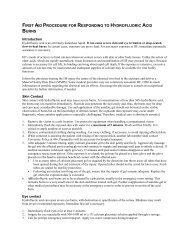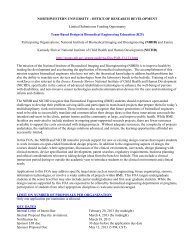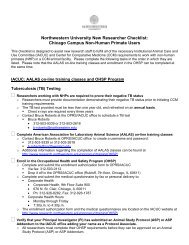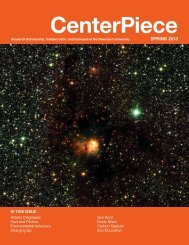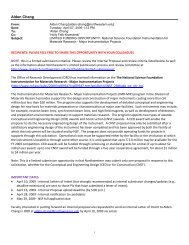annual report 2011 - Office for Research - Northwestern University
annual report 2011 - Office for Research - Northwestern University
annual report 2011 - Office for Research - Northwestern University
You also want an ePaper? Increase the reach of your titles
YUMPU automatically turns print PDFs into web optimized ePapers that Google loves.
Members of the Bažant research group in the lab. From left: Jan Vorel, visiting scholar from Czech Technical <strong>University</strong>, Prague; Mija Hubler, doctoral candidate;<br />
Bažant; Christian Hoover, doctoral candidate; Roman Wendner, visiting scholar from Universität für Bodenkultur Wien, Vienna; Mahendra Gattu, graduate<br />
research assistant; Kyung-Tae Kim, doctoral candidate; and Kedar Kirane, graduate research assistant. Missing from the photo are Jorg Unger, visiting scholar<br />
from <strong>University</strong> of Weimar, Germany and Steve Albertson, lab technician.<br />
Zdenĕk P. Bažant<br />
McCormick School of Engineering and<br />
Applied Science<br />
Analyzing Structural Failure, Safety,<br />
and Durability<br />
A fifth-generation civil engineer, Zdeněk P. Bažant, civil and<br />
environmental engineering, is known as a world leader in<br />
scaling research in solid mechanics. His research focuses<br />
on the effect of structure size on structural strength as<br />
it relates to the failure behavior of structures. He has<br />
also made outstanding advances in structural stability,<br />
fracture mechanics, the micromechanics of material<br />
damage, concrete creep, drying, thermal and corrosive<br />
effects in concrete, finite-strain continuum mechanics, and<br />
probabilistic mechanics of structural strength and of long<br />
time de<strong>for</strong>mation.<br />
At <strong>Northwestern</strong> he focused first on concrete creep and<br />
hygrothermal effects (i.e., heat and humidity). What he<br />
calls his “cleanest simple result,” the AAEM method (Age-<br />
Adjusted Effective Modulus Method), is now featured in<br />
virtually all design codes and standard recommendations.<br />
The method makes possible an easy approximate<br />
assessment of aging and drying influences on longtime<br />
de<strong>for</strong>mations of concrete structures.<br />
Of all his work, Bažant is probably best known <strong>for</strong> his size-<br />
effect law, a deceptively simple <strong>for</strong>mula that explains why<br />
the strength of large quasi-brittle structures is lower than<br />
predicted by the classical strength theory and reflects the<br />
fact that quasi-brittle failure of structures is decided by both<br />
material strength and energy dissipated by fracture. He<br />
revolutionized the scaling theory by deriving his simple law<br />
of broad applicability, bridging asymptotically the scaling<br />
laws of plasticity and classical fracture mechanics. Bažant<br />
demonstrated theoretically that, in quasi-brittle failure that<br />
is preceded by large stable growth of localized fracture or<br />
distributed cracking damage, the size effect is not statistical<br />
but is caused mainly by stress redistribution and localization<br />
of cracking damage associated with the release of energy<br />
stored in the structure. He showed that the neglect of size<br />
effect in design was a significant contributing factor in many<br />
famous structural failures, including the Malpasset and St.<br />
Francis dams, the giant Sleipner oil plat<strong>for</strong>m, the viaducts in<br />
Oakland and Kobe earthquakes, the Schoharie Creek Bridge,<br />
and other structures.<br />
Bažant’s groundbreaking concepts have been applied to<br />
numerous disciplines, including the design of concrete<br />
structures, ship and aircraft engineering, arctic ice<br />
engineering, geotechnical and mining engineering,<br />
petroleum engineering, nuclear safety, earthquake-resistant<br />
design, blast, groundshock and impact, and the assessment<br />
of the danger of snow avalanches. He was the first to<br />
explain the 9/11 gravity-driven collapse of the World Trade<br />
Center. Bažant recently has been studying the fluid pressure<br />
effects in nano-porous solids, the scaling of strength of<br />
polycrystalline metals on approach to the nanoscale, and<br />
the probability distribution of strength and lifetime of quasi-<br />
brittle structures from atomistic concepts.<br />
Excellence in <strong>Research</strong> | Annual Report <strong>2011</strong> 29<br />
Andrew Campbell






